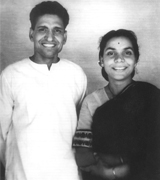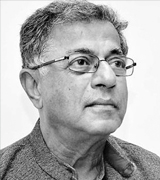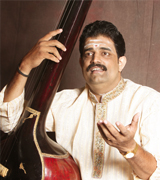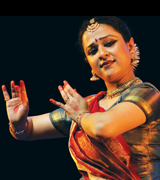COVER STORY
75 YEARS OF GANDHARVA MAHAVIDYALAYA
SHRINKHLA SAHAI

Tucked away near the bylanes of one of the busiest areas of Delhi is the yellow and red building. It stands tall yet humble, quietly taking in the changing times, gracefully maintaining its distance from the frenzied impatience of everyday life passing by. As I walk through the entrance, the rhythm of life transforms from the racy traffic orchestra to the serene melody of swaying trees and drifting sounds of music and dance. A student passes by humming an unfamiliar tune. I stop as he pauses to recollect the next phrase, with a triumphant smile he renews the humming, greets me with a nod and walks out with the tune. As I gaze at his receding figure I wonder how far out into the city the tune will travel, whether the melodic strains will seek an unexplored harmony with the humdrum of politics, protest and profits that drive life in the capital. It has been 75 years since Gandharva Mahavidyalaya was established, and the music continues to flow into and enrich the cultural life of Delhi.
The genesis
It was this vision of revitalising the arts and creating a strong foundation for performers and rasikas in the city that drove Vinaya Chandra Maudgalya to start the Gandharva Mahavidyalaya in 1939. Following the ideology of Vishnu Digambar Paluskar who founded the first music school of its kind in 1901, Maudgalya started the classes at his home, an old apartment in Regal Building in Connaught Place. Up against the orthodox attitudes, lack of awareness and inertia of the general public, he continued to work towards the propagation of Indian classical music and dance. A disciple of the renowned Hindustani vocalist of the Gwalior gharana, Vinayak Rao Patwardhan, Maudgalya’s life journey (1918-1995) is a story of the pursuit of this undying zeal. He was assisted by his wife Padma Devi and brothers Vipin Chandra and Pramod Chandra. In the absence of performance spaces in the capital during the 1940s, baithaks would often take place at Maudgalya’s residence. Bade Ghulam Ali Khan, Vilayat Khan, Ravi Shankar, Dagar Brothers, Omkar Nath Thakur, Kumar Gandharva, V.G. Jog, and Narayan Rao Vyas were some of the stalwarts who often performed and stayed at the Vidyalaya.
SPECIAL FEATURE
“Theatre has no substitute”
GIRISH KARNAD IN CONVERSATION WITH GOWRI RAMNARAYAN

Veteran playwright Girish Karnad received the Nataka Choodamani award from Sri Krishna Gana Sabha, Chennai, on 12 April 2014.
Arguably the best known playwright in contemporary India, actor, director, critic, translator, cultural interventionist Girish Raghunath Karnad rightfully claims to have created a modern theatre for the nation along with giants Dharamvir Bharati, Mohan Rakesh, Badal Sircar and Vijay Tendulkar. Born on 19 May 1938 in Matheran, Maharashtra, in a Saraswat Brahmin family, Karnad did his M.A. in Oxford as a Rhodes Scholar. Dreaming of international fame as a poet in English, Karnad ended up writing in his adopted language Kannada, starting with Yayati (1961), famously drafted on the way to England.
On his return to India, he worked at the Oxford University Press, Madras (1963-70) before turning scriptwriter, actor and director in multiple award-winning landmark films – Samskara (1970), Vamsavruksha (1972), Kaadu (1974), Ondanondu Kaladalli (1978), and the non-feature Kanaka Purandara (1989). Apart from acting in mainstream cinema, Karnad has also played many significant roles in parallel cinema, notably with Shyam Benegal. He is also remembered for his role in the televised version of R.K. Narayan’s Swami and Friends.
FROM THE WINGS
CONVERSATIONS WITH MUSICIANS IN CLASSICAL DANCE
ANJANA ANAND

Kaniyal Hari Prasad, a Kalakshetra alumnus and one of the most sought after dance vocalists in the field,juggles his time as a teacher at Kalakshetra, dance vocalist, and kutcheri performer. Known for his meticulous preparation despite his hectic schedule, Hari Prasad works in tandem with the dancer to create a dance-music synergy. He speaks about his background in music, and his views on the need for artists to work together to ensure that classicism in dance music is not lost. An artist who does not want to be labelled as only a ‘dance vocalist’, Hari Prasad aspires to continue his career as a kutcheri
musician.
A word about your beginnings in music?
I learnt music from Govinda Bhagavatar for 15 years in Kerala. Music was part of my family though no member was a professional musician. I had my music arangetram at Guruvayur along with my sister. After my pre-degree, I saw an advertisement about Kalakshetra and applied for admission to the music course. I was in Kalakshetra from 1988 to 1991 and learnt from Salem Chellam Iyengar, Vairamangalam Lakshminarayanan and S. Rajaram.
I was fortunate to have learnt compositions of vidwan M. Balamuralikrishna directly from the great musician. For the last few years I was training with V. Subrahmanyam (who passed away in November 2013), a senior disciple of Semmangudi.
NEWS & NOTES
Tarpan – an offering by Gandharva Mahavidyalaya
SUNIL KOTHARI

Gandharva Mahavidyalaya New Delhi presented Tarpan (an offering) – a festival of dance and music (23-30 March) – at Kamani to mark the 75th year celebrations of the institution. It was a runaway success. The institution established in 1939 by Vinaya Chandra Maudgalaya, is a historical landmark in the capital as it enabled the vertical and horizontal growth of Hindustani classical music. It is now run competently by Maudgalya’s son Madhup Mudgal who is the Principal. During the festival, a book which traces the history of the institution with rare photographs was released. A galaxy of musicians and dancers are featured in the volume designed by Vinay Jain.
Tarpan was conceived as three segments. The Gandharva Choir and group choreographies in Odissi by the students of Gandharva Mahavidyalaya were presented on the opening day. Some of the best young talent in classical dance was presented two on each day from 24th to 26th March. The last three days featured stalwarts of music, many of whom have been closely associated with the Gandharva Mahavidyalaya for many years.


